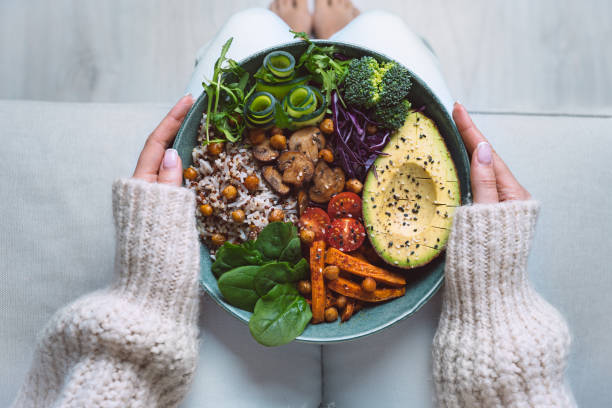“Clean eating” is more than just a diet trend; it’s a lifestyle approach to food that emphasizes whole, minimally processed, and nutrient-rich ingredients. Instead of counting calories or following restrictive rules, clean eating focuses on quality, freshness, and balance, making it a sustainable way to nourish your body. In this guide, we’ll explore what clean eating is, which foods to include and avoid, its benefits, and a 7-day sample clean eating diet chart.
What is Clean Eating?
Clean eating means choosing natural, whole foods in their most unrefined form and limiting or avoiding heavily processed and artificial foods. It’s not about perfection but about making conscious, healthier food choices.
The key principles of clean eating are:
- Choose whole foods like fruits, vegetables, lean proteins, whole grains, and healthy fats.
- Avoid ultra-processed foods with added sugars, preservatives, and artificial ingredients.
- Focus on balance, include protein, carbs, and healthy fats in meals.
- Stay hydrated with water, herbal teas, and infused water instead of sugary drinks.
- Practice mindful eating and pay attention to hunger cues and portion sizes.
Foods to Include in a Clean Eating Diet:
When following a clean eating lifestyle, the focus is on whole, nutrient-rich foods that fuel your body naturally and support overall health. These are foods that are minimally processed, close to their original form, and free from artificial additives. Fresh fruits and vegetables, whole grains, lean proteins, healthy fats, and natural beverages form the backbone of a clean diet. By choosing these wholesome ingredients, you ensure your meals are not only healthier but also rich in vitamins, minerals, fiber, and antioxidants that keep your body energized and strong.
Fruits & Vegetables:
- Fresh, seasonal, and organic when possible
- Leafy greens (spinach, kale), cruciferous vegetables (broccoli, cauliflower), colorful fruits (berries, oranges, apples, bananas)
Whole Grains:
- Brown rice, quinoa, oats, buckwheat, millet, barley
- Whole-grain bread and pasta (without added preservatives)
Lean Proteins:
- Chicken, turkey, fish, eggs (pasture-raised if possible)
- Plant-based proteins: beans, lentils, chickpeas, tofu, tempeh
Healthy Fats:
- Avocados, nuts (almonds, walnuts), seeds (chia, flax, pumpkin, sunflower)
- Olive oil, coconut oil (cold-pressed), nut butters (unsweetened)
Dairy & Alternatives (choose minimally processed):
Plain Greek yogurt, unsweetened plant-based milk (almond, oat, coconut)
Beverages:
Water, coconut water, herbal teas, and homemade fruit-infused water
Foods to Avoid in a Clean Eating Diet
- Refined grains: white bread, white rice, sugary cereals
- Processed meats: sausages, hot dogs, deli meats
- Packaged snacks & fast food: chips, fries, burgers, instant noodles
- Sugary drinks & alcohol: soda, energy drinks, excessive alcohol
- Added sugars & sweets: candy, pastries, cookies, ice cream
- Artificial additives & preservatives: MSG, food coloring, artificial sweeteners
Benefits of Clean Eating:
- Improved Digestion: High fiber intake from whole foods supports gut health.
- Stable Energy Levels: Whole grains and balanced meals prevent sugar spikes.
- Weight Management: Nutrient-dense foods reduce cravings and overeating.
- Better Skin Health: Antioxidants in fruits & vegetables promote a clear complexion.
- Heart Health: Healthy fats and lean proteins reduce cholesterol levels.
- Stronger Immunity: Vitamins and minerals from fresh produce boost defenses.
- Mental Wellbeing: Balanced nutrition helps stabilize mood and reduce fatigue.
7-Day Clean Eating Diet Chart:
Here’s a sample 7-day clean eating plan:
Day 1:
- Breakfast: Oatmeal with banana, chia seeds, and cinnamon
- Snack: Apple slices with almond butter
- Lunch: Grilled chicken breast, quinoa, steamed broccoli
- Snack: Carrot sticks with hummus
- Dinner: Baked salmon with roasted sweet potatoes and spinach
Day 2:
- Breakfast: Greek yogurt with fresh berries and flax seeds
- Snack: Handful of walnuts + pear
- Lunch: Brown rice, lentil curry, sautéed green beans
- Snack: Rice cakes with avocado
- Dinner: Grilled turkey with zucchini noodles and side salad
Day 3:
- Breakfast: Smoothie (spinach, banana, oats, almond milk)
- Snack: Cucumber slices with hummus
- Lunch: Quinoa salad (chickpeas, cucumber, tomato, olive oil)
- Snack: Fresh orange + pumpkin seeds
- Dinner: Baked cod with roasted carrots and kale
Day 4:
- Breakfast: Amaranth porridge with apple slices & cinnamon
- Snack: Mixed berries
- Lunch: Grilled chicken lettuce wraps + avocado salsa
- Snack: Handful of sunflower seeds + green tea
- Dinner: Stir-fried tofu with broccoli, bell peppers, and brown rice
Day 5:
- Breakfast: Overnight oats with almond milk, blueberries & chia seeds
- Snack: Banana + 2 dates
- Lunch: Grilled salmon, quinoa, roasted asparagus
- Snack: Roasted chickpeas
- Dinner: Turkey patties with mashed sweet potato and green beans
Day 6:
- Breakfast: Smoothie bowl (mango, spinach, oat milk, topped with seeds)
- Snack: Pear slices + almond butter
- Lunch: Brown rice bowl with lentils, steamed broccoli, and carrots
- Snack: Fresh coconut water + handful of cashews
- Dinner: Grilled chicken with zucchini noodles & sautéed spinach
Day 7:
- Breakfast: Buckwheat pancakes with berries (no refined sugar)
- Snack: Apple + sunflower seeds
- Lunch: Quinoa bowl with chickpeas, avocado, cucumber, and olive oil dressing
- Snack: Herbal tea + baked sweet potato wedges
- Dinner: Baked salmon with roasted beets & kale salad
Conclusion:
Clean eating is not about strict rules; it’s about choosing natural, nutrient-rich foods and avoiding processed, chemical-laden items. By following this lifestyle, you can enjoy better energy, improved digestion, clearer skin, and overall wellness. The 7-day diet chart provides a practical roadmap to start your clean eating journey today.
